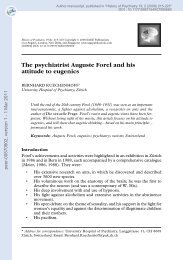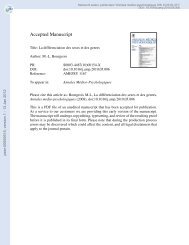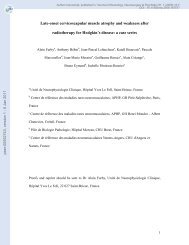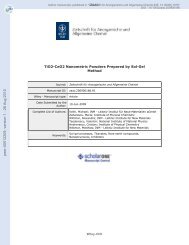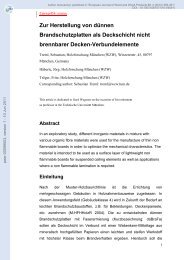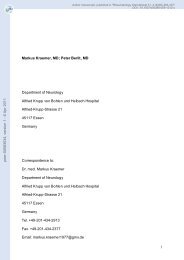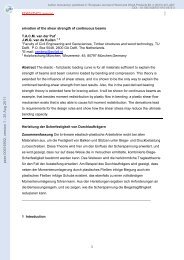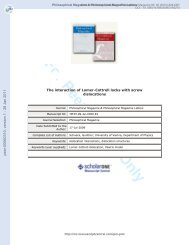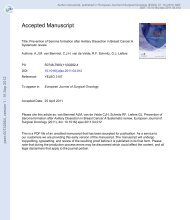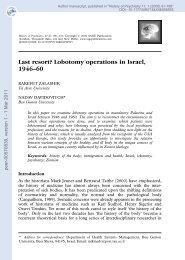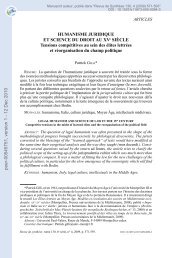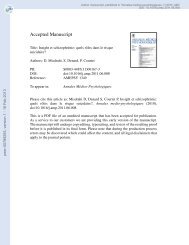Monitoring of Polycyclic Aromatic Hydrocarbons (PAH) in food ...
Monitoring of Polycyclic Aromatic Hydrocarbons (PAH) in food ...
Monitoring of Polycyclic Aromatic Hydrocarbons (PAH) in food ...
You also want an ePaper? Increase the reach of your titles
YUMPU automatically turns print PDFs into web optimized ePapers that Google loves.
1<br />
2<br />
3<br />
4<br />
5<br />
6<br />
7<br />
8<br />
9<br />
10<br />
11<br />
12<br />
13<br />
14<br />
15<br />
16<br />
17<br />
18<br />
19<br />
20<br />
21<br />
22<br />
23<br />
24<br />
25<br />
26<br />
27<br />
28<br />
29<br />
30<br />
31<br />
32<br />
33<br />
34<br />
35<br />
36<br />
37<br />
38<br />
39<br />
40<br />
peer-00704676, version 1 - 6 Jun 2012<br />
41<br />
42<br />
43<br />
44<br />
45<br />
46<br />
47<br />
48<br />
49<br />
50<br />
51<br />
52<br />
53<br />
54<br />
55<br />
56<br />
57<br />
58<br />
59<br />
60<br />
The results were with<strong>in</strong> the range found <strong>in</strong> our survey but the number <strong>of</strong> samples was too low for a mean<strong>in</strong>gful<br />
comparison.<br />
Maximum levels for contam<strong>in</strong>ants <strong>in</strong> European Food law should be set at a level, which is as low as<br />
reasonably achievable (ALARA) when these contam<strong>in</strong>ants are considered to be genotoxic carc<strong>in</strong>ogens<br />
(European Commission 2006). In this respect, it was <strong>in</strong>terest<strong>in</strong>g to note that overall <strong>in</strong> 192 (58%) <strong>of</strong> the<br />
supplements <strong>in</strong> our 2008 and 2009 survey (n=333), <strong>PAH</strong>4 levels were lower than 10 µ g kg -1 and <strong>in</strong> 99 (30% <strong>of</strong><br />
For Peer Review Only<br />
the total) <strong>of</strong> these <strong>PAH</strong>4 levels were below the LOQ. Furthermore, <strong>in</strong> all subcategories <strong>of</strong> <strong>food</strong> supplements<br />
identified <strong>in</strong> this survey there were supplements that conta<strong>in</strong>ed no quantifiable or relatively low levels (here<br />
def<strong>in</strong>ed as <strong>PAH</strong>4 level below 10 µ g kg -1 ) <strong>of</strong> <strong>PAH</strong>. This suggests that contam<strong>in</strong>ation <strong>of</strong> <strong>food</strong> supplements with <strong>PAH</strong><br />
is avoidable.<br />
<strong>PAH</strong> levels <strong>of</strong> <strong>food</strong> supplements reported by EFSA<br />
Food Additives and Contam<strong>in</strong>ants<br />
EFSA reported <strong>in</strong> 2008 <strong>in</strong> an Op<strong>in</strong>ion <strong>of</strong> the Panel on Contam<strong>in</strong>ants <strong>in</strong> the Food Cha<strong>in</strong> on <strong>PAH</strong> <strong>in</strong> <strong>food</strong>, lower and<br />
upper bound mean benzo[a]pyrene, <strong>PAH</strong>2, <strong>PAH</strong>4, and <strong>PAH</strong>8 levels <strong>of</strong> 283 <strong>food</strong> supplements derived from data<br />
submitted to EFSA by five European countries, <strong>in</strong>clud<strong>in</strong>g the UK (EFSA 2008a). The lower bound mean levels for<br />
these parameters were 2.78, 12.8, 23.7, and 30.0 µ g kg -1 , respectively (EFSA 2008b). We found <strong>in</strong> 2008 and<br />
2009 higher values for these parameters, which amounted to respectively 5.33, 20.8, 33.8, and 40.9 µ g kg -1 . Our<br />
sampl<strong>in</strong>g protocol was targeted at supplements with relatively high <strong>PAH</strong> levels, whereas the data submitted to<br />
EFSA were obta<strong>in</strong>ed by both targeted and random sampl<strong>in</strong>g. Mean <strong>PAH</strong>4 levels <strong>in</strong> <strong>food</strong> supplements came<br />
second <strong>in</strong> the EFSA Op<strong>in</strong>ion after levels <strong>in</strong> dried tea samples, which showed a lower bound mean <strong>of</strong> 42.7 µg kg -1<br />
<strong>PAH</strong>4 (EFSA 2008b). The highest <strong>in</strong>dividual <strong>PAH</strong> level reported for <strong>food</strong>s tested for all 15 SCF priority <strong>PAH</strong> was<br />
1064 µ g kg -1 benz[a]anthracene <strong>in</strong> t<strong>in</strong>ned sprats. Accord<strong>in</strong>g to EFSA this value was possibly an aberration,<br />
however. The second and third highest <strong>in</strong>dividual <strong>PAH</strong> levels (690 µg kg -1 <strong>of</strong> benzo[b]fluoranthene and 590 µ g<br />
kg -1 <strong>of</strong> chrysene, respectively) were found <strong>in</strong> <strong>food</strong> supplements (EFSA 2008b). In the category <strong>of</strong> supplements, a<br />
black tea supplement showed the highest comb<strong>in</strong>ed <strong>PAH</strong> concentrations and a supplement with spirul<strong>in</strong>a and one<br />
with propolis extract showed the second and third highest concentrations, respectively (EFSA 2008a). In our<br />
study, the highest and second highest <strong>in</strong>dividual <strong>PAH</strong> levels were found <strong>in</strong> <strong>food</strong> supplements with resveratrol<br />
amount<strong>in</strong>g to 503 and 474 µ g kg -1 benzo[c]fluorene, respectively. EFSA received data on benzo[c]fluorene <strong>in</strong> only<br />
http://mc.manuscriptcentral.com/tfac Email: fac@tandf.co.uk<br />
16<br />
Page 16 <strong>of</strong> 40




